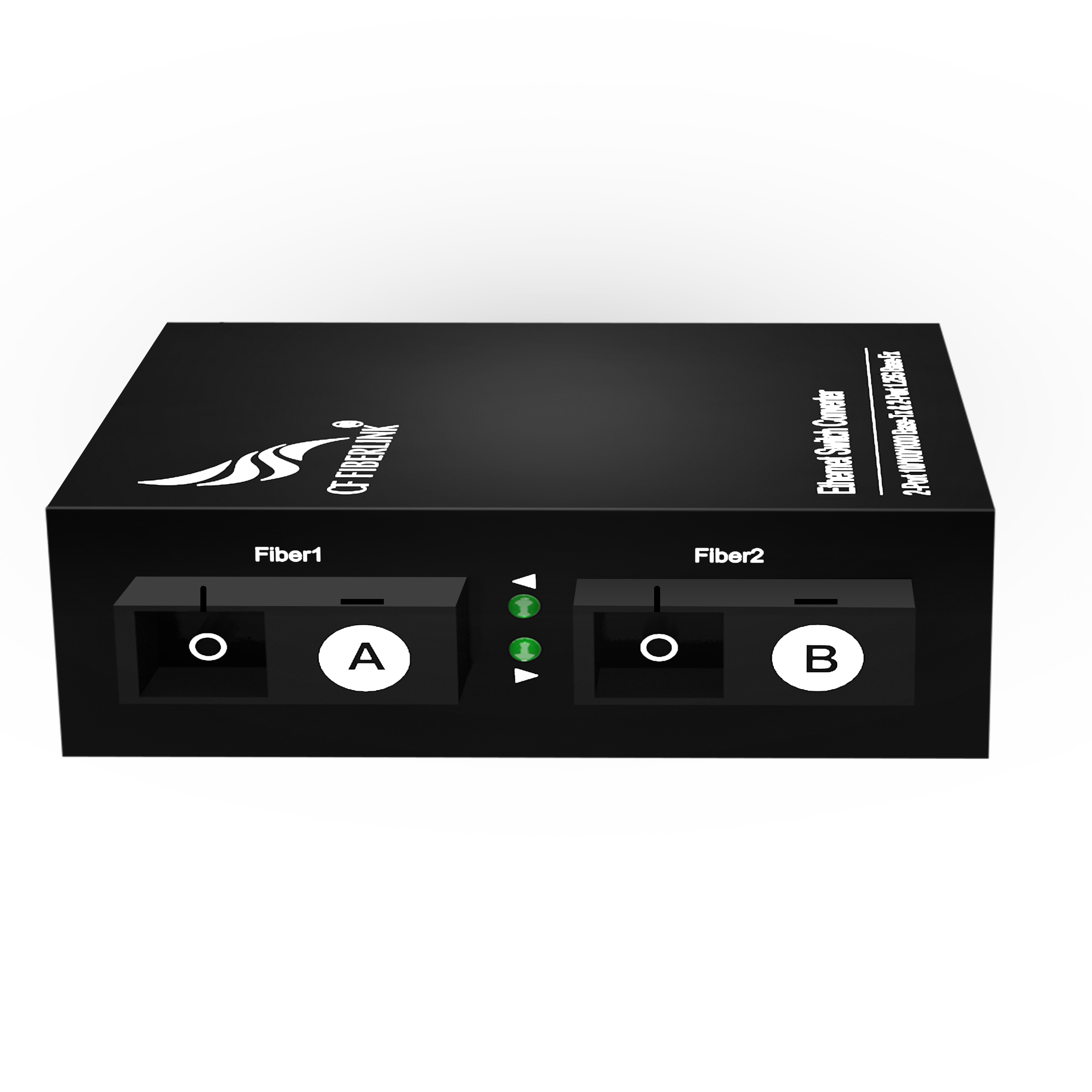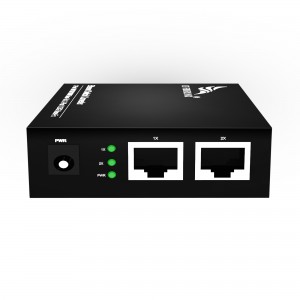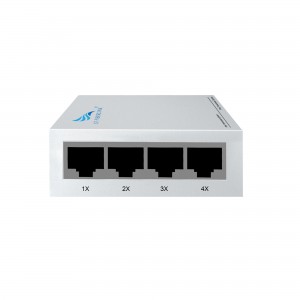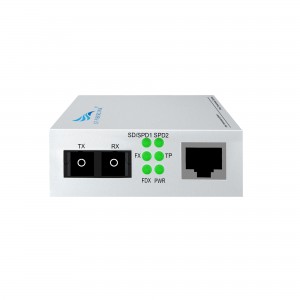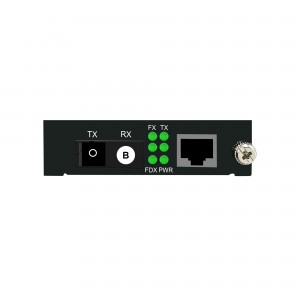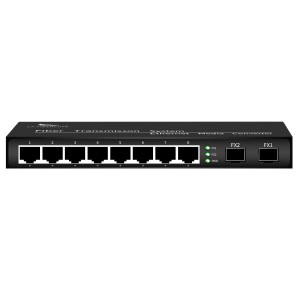4-port 10/100/1000M WDM Media Converter (Single-mode Single-fiber SC)
4-port 10/100/1000M WDM Media Converter (Single-mode Single-fiber SC)
Product Features:
Huizhou Changfei Optoelectronics Technology Co., Ltd. launched a gigabit 2 optical 2 electrical single-mode single-fiber compact optical fiber transceiver, which is the latest innovation of Huizhou Changfei Optoelectronics Technology Co., Ltd.’s connectivity solutions. As a leading manufacturer of Industrial Smart Managed Switches, PoE Switches, Ethernet Switches, Wireless Bridges and Wireless 4G Routers, we continuously strive to provide high-quality products to meet the ever-changing needs of our customers.
Our compact fiber optic media converters are designed to optimize network performance, provide seamless conversion between different types of network media, and ensure efficient data transmission over long distances. Featuring two fiber optic ports and two electrical ports, this media converter provides the flexibility and reliability required for a variety of networking applications.
One of the standout features of this media converter is its low power consumption, making it an eco-friendly choice for businesses. By utilizing advanced technologies, we have developed a solution that minimizes energy consumption without compromising performance. This not only helps reduce operating costs, but also contributes to a greener environment.
In addition to power saving features, our Gigabit 2 Optical 2 Electrical Single Mode Single Fiber Compact Optical Media Converter also boasts a 4-digit dial for ease of use. This user-friendly interface can be easily configured and managed, making it ideal for experienced network administrators and network novices alike.
For seamless connection, the transceiver is equipped with SC interface, which can be easily connected with various fiber optic cables. The SC interface ensures reliable data transmission with minimal signal loss even over long distances. With dynamic LED indicators, users can quickly monitor network connection status to ensure smooth operation and timely troubleshooting.
As an unmanaged fiber converter, the product provides plug-and-play functionality without complicated installation procedures. Simply connect your device and the media converter will automatically detect and configure the optimal settings for efficient data transfer. This hassle-free setup saves time and resources, further enhancing the convenience and productivity of your network infrastructure.
At Huizhou Changfei Optoelectronics Technology Co., Ltd., we are committed to providing cutting-edge network solutions to help businesses thrive in today’s digital environment. The Gigabit 2 Optical 2 Electrical Single Mode Single Fiber Compact Fiber Media Converter is a testament to our commitment to innovation, performance and reliability.
With a no-nonsense tone that befits our marketing approach, we invite you to experience the benefits of our high-quality connectivity solutions. Stay ahead of the competition and unlock new opportunities for seamless data transfer across your network infrastructure with our state-of-the-art compact fiber optic media converters. We believe that Huizhou Changfei Photoelectric Technology Co., Ltd. will provide you with reliable and efficient network solutions.
What This Product Does
◇ CF-2012GSW-3 is a gigabit media converter that provides gigabit RJ-45 ports and gigabit SC fiber optic ports for conversion between electrical and optical signals.
How This Product Works
◇ CF-2012GSW-3 adopts WDM (Wavelength-division multiplexing) technology, each optical port can receive and send data at the same time with only one single mode fiber, and the maximum transmission distance can reach 3 kilometers. It can convert the electric port signal and the optical port signal, and carry out remote data transmission through optical fiber.
◇The CF-2012GSW-3 has both A and B optical ports, which are convenient for pairing with the opposite end and can form a cascaded topology. Compared with conventional single port fiber optic transceivers, it is more flexible to use.
Other Features
◇ In addition, the media converter can be used as a standalone device for automatic MDI/MDI-X in the TX port, where duplex mode is automatically negotiated.
technical parameter:
|
Model |
CF-2012GSW-3 | |
| Interface Characteristics | ||
|
Fixed Port |
2* 10/ 100/ 1000Base-T RJ45 port 2* 1000Base-X uplink SC fiber port |
|
|
Ethernet Port |
10/ 100/ 1000Base-T auto-sensing, full/half duplex MDI/MDI-X self-adaption |
|
|
Twisted Pair Transmission |
10BASE-T: Cat3,4,5 UTP(≤100 meter) 100BASE-T: Cat5e or later UTP(≤100 meter) 1000BASE-T : Cat5e or later UTP(≤100 meter) |
|
| Optical Port | Default optical module is single-mode single-fiber 3km, SC port | |
| Wavelength/Distance | A-end: RX1310nm / RX1550nm 0 ~ 40KM
B-end:RX1550nm/ RX1310nm 0 ~ 40KM |
|
| A-end: RX1490nm / RX1550nm 0 ~ 120KM
B-end:RX1550nm/ RX1490nm 0 ~ 120KM |
||
| Chip Parameter | ||
| Network Protocol | IEEE802.3 10BASE-T, IEEE802.3i 10Base-T,
IEEE802.3u 100Base-TX, IEEE802.3u 100Base-FX, IEEE802.3x IEEE802.3ab 1000Base-T;IEEE802.3z 1000Base-X; |
|
|
Forwarding Mode |
Store and Forward(Full Wire Speed) |
|
|
Switching Capacity |
8Gbps |
|
|
Buffer Memory |
5.95Mpps | |
|
MAC |
2K | |
|
LED Indicator |
Fiber | Fiber1/Fiber2 |
| Data | 1X/2X (green) | |
| Power | PWR (green) | |
| Power | ||
| Working Voltage |
AC:100-240V |
|
|
Power Consumption |
Standby<1W, Full load<5W |
|
|
Power Supply |
DC:5V/2A industrial power supply |
|
| Lightning protection &Certification | ||
| Lightning protection | Lightning protection: 4KV 8/20us, Protection level: IP30 | |
| Certification | CCC;CE mark, commercial; CE/LVD EN60950;FCC Part 15 Class B; RoHS | |
| Physical Parameter | ||
| Operation TEMP | -20~+55°C;5%~90% RH Non condensing | |
| Storage TEMP |
-40~+85°C;5%~95% RH Non condensing |
|
| Dimension (L*W*H) | 88mm* 71mm*27mm | |
| Installation | Desktop | |
Product Size:
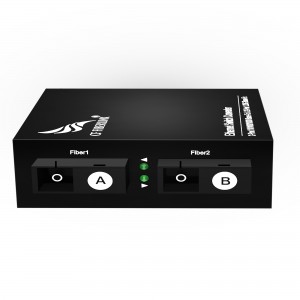
Product application diagra:

How to choose a fiber optic transceiver?
Optical fiber transceivers break the 100-meter limitation of Ethernet cables in data transmission. Relying on high-performance switching chips and large-capacity caches, while truly achieving non-blocking transmission and switching performance, they also provide balanced traffic, isolation and conflict. Error detection and other functions ensure high security and stability during data transmission. Therefore, fiber optic transceiver products will still be an indispensable part of actual network construction for a long time. So, how should we choose fiber optic transceivers?
1. Port function test
Mainly test whether each port can work normally in the duplex state of 10Mbps, 100Mbps and half-duplex state. At the same time, it should be tested whether each port can automatically select the highest transmission speed and automatically match the transmission rate of other devices. This test can be included in other tests.
2. Compatibility test
It mainly tests the connection ability between the optical fiber transceiver and other devices compatible with Ethernet and Fast Ethernet (including network card, HUB, Switch, optical network card, and optical switch). The requirement must be able to support the connection of compatible products.
3. Cable connection characteristics
Test the fiber optic transceiver’s ability to support network cables. First, test the connection ability of Category 5 network cables with lengths of 100m and 10m, and test the connection ability of long Category 5 network cables (120m) of different brands. During the test, the optical port of the transceiver is required to have a connection capability of 10Mbps and a rate of 100Mbps, and the highest must be able to connect to a full-duplex 100Mbps without transmission errors. Category 3 twisted pair cables may not be tested. Subtests can be included in other tests.
4. Transmission characteristics (transmission loss rate of data packets of different lengths, transmission speed)
It mainly tests the packet loss rate when the optical fiber transceiver optical port transmits different data packets, and the connection speed under different connection rates. For the packet loss rate, you can use the test software provided by the network card to test the packet loss rate when the packet size is 64, 512, 1518, 128 (optional) and 1000 (optional) bytes under different connection rates. , the number of packet errors, the number of packets sent and received must be more than 2,000,000. Test transmission speed can use perform3, ping and other software.
5. The compatibility of the whole machine to the transmission network protocol
It mainly tests the compatibility of fiber optic transceivers to network protocols, which can be tested in Novell, Windows and other environments. The following low-level network protocols such as TCP/IP, IPX, NETBIOS, DHCP, etc. must be tested, and the protocols that need to be broadcast must be tested. Optical transceivers are required to support these protocols (VLAN, QOS, COS, etc.).
6. Indicator status test
Test whether the status of the indicator light is consistent with the description of the panel and the user manual, and whether it is consistent with the current status of the fiber optic transceiver.


